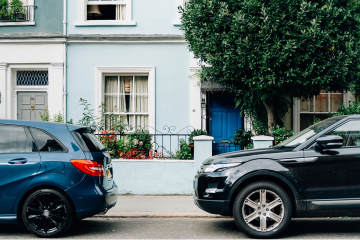Misfuelling can happen for all sorts of reasons. Maybe you've just switched to a new car, or you're simply distracted at the pump. It's easy to think, "That would never happen to me", but it's actually more common than you might imagine.
In this guide, we'll walk you through what to do if it happens, and whether your insurer will cover the cost. Let's begin!
What is misfuelling?
Misfueling is when you put the incorrect fuel into your vehicle. It might seem like one of those mistakes you'd never make - until it happens. 150,000 drivers mis-fuel each year - that's according to RAC.
The most frequent scenario is petrol being put into a diesel car. That's because petrol pump nozzles are smaller and can fit easily into diesel tanks.
On the other hand, diesel nozzles are larger and don't fit into most petrol tanks. So, this reverse mistake is usually less common.
Is misfuelling covered by car insurance?
This depends on what car insurance policy you've got. Some insurers might cover the entirety of the repair as standard.
But, others might only cover certain parts of it, like the cost of draining the engine and cleaning it out.
The best thing to do is to read your policy details to know exactly what cover you've got. Or, give your insurer a call.
What damage can misfuelling do to my car?
The damage caused by misfuelling depends on whether you've put petrol into a diesel car or diesel into a petrol car. While both situations can harm your vehicle, the severity can vary.
Let's break it down in the following sections.
What happens if you put petrol in a diesel car
Putting petrol in a diesel car can cause significant damage - potentially even total engine failure.
Diesel engines rely on the lubrication properties of diesel fuel to keep internal components running smoothly.
Unfortunately, petrol can act as a solvent and strip away this lubrication.
Without proper lubrication, the metal parts of your car can rub together. This can cause friction and wear that can lead to issues like:
- Damage to fuel injectors. These parts control how fuel is sprayed into the engine. If they get damaged, your car might struggle to start, run roughly or even stop altogether.
- Pump failure. The fuel pump moves fuel through the engine. Diesel fuel is thicker and helps lubricate the pump, but petrol can cause it to wear out or break. This can stop the fuel from flowing through the system properly.
- Complete engine breakdown. Without the right fuel and lubrication, the engine parts can start to grind together. This could lead to the engine breaking down, which might mean expensive repairs or even a replacement.
What happens if you put diesel in a petrol car?
The good news? Putting diesel in a petrol car is usually less damaging than the other way round. But, the bad news is that it can still cause issues that require repairs.
Petrol engines rely on spark plugs to ignite the fuel. Diesel, being thicker and less flammable, doesn't ignite the same way petrol does.
When you put diesel into a petrol tank, it disrupts this process and often prevents the engine from starting. In most cases, draining the tank and refilling it with petrol can solve the problem.
But, if the engine does manage to start with diesel in the system, this could be where the trouble begins. You might notice:
- Difficulty starting the car. Petrol engines rely on spark plugs to ignore the fuel, but diesel doesn't ignite easily. If you put diesel in a petrol car, the engine might not start at all because the fuel won't burn properly.
- Engine problems if the car does start. If you manage to get the car running, you might notice the engine smoking, stalling or even cutting off suddenly. The engine could also run very roughly, which could cause further damage.
What should I do if I put the wrong fuel in my car?
This depends when you realise. Generally, try and do the following:
-
Don’t start the engine. If you realise your mistake still at the pump, don't start the car. This could significantly damage the car. If the car has started and you've started to pull away, pull over when safe.
-
Turn the engine off and make sure the car is in neutral. Alert the petrol station staff. If you're still in the station, make the staff aware. They'll be able to help you.
-
Make sure the car is in a safe place. If the car is still at the petrol station, you could ask the staff to help you push the car to a safe place away from the pumps.
-
Contact your breakdown company. Contact the breakdown company listed in your breakdown cover. They'll be able to help you out. If you don't already have breakdown cover, you can still call a breakdown company. Just keep in mind that they might charge for the call out.
-
Contact your insurer. Make your insurer aware of what's happened. If you're covered for misfuelling, they might have specific instructions you need to follow.
What happens if I misfuel with E10 fuel?
If you accidentally put E10 petrol in a vehicle that isn't compatible, don't stress! There's usually no need to get the tank drained.
Just fill up the tank with the correct fuel as soon as you can to dilute any E10 left inside. This simple step can prevent any potential issues.
But, regularly using E10 in a car that isn't compatible could lead to internal damage over time. E10 contains 10% renewable ethanol, compared to premium unleaded which contains 5%.
While most modern cars are designed to handle it, some older vehicles might not be. You can check if your car is compatible with E10 fuel on GOV.UK.
How do I make a claim for misfuelling?
Making a claim for misfuelling is similar to making any other type of claim!
Contact your insurer as soon as possible. You should be able to find the contact number you need to call in your policy details.
Gather any receipts for repairs or breakdown services, as your insurer may ask for these as proof when processing the claim.
Top tip: Before you make the call, take a quick look at your policy details to check if you're covered for misfuelling - this will save you time!
Will I lose my no claims bonus?
There's a possibility, yes. But, it's not always the case! Most of the time, making a claim just reduces your discount a little - it doesn't wipe it out completely.
The extent of the impact usually depends on how many claims your insurer allows within a set period, and how serious the claim is.
So, grab your policy documents, have a quick read-through, and see where you stand.
Will my insurance go up?
Maybe. Some insurers might adjust your premium after making a claim, even for smaller things like misfuelling.
Before your renewal comes around, it might be helpful to work out the cost of the repair along with your voluntary excess.
By doing so, you can decide whether it's worth making a claim or just handling it yourself.
How much will the repair be?
This depends on the extent of the damage, and whether you've put diesel in a petrol car or vice versa. Like we've said, diesel in a petrol car tends to cause more damage, so it can lead to higher repair bills.
On average, repairs can cost anything between £120 to £1K - that's according to Which.
Helpful hint: It might be worth getting quotes from a few local garages before proceeding.
How can I prevent misfuelling?
Here's some tips to avoid an unwanted mix-up at the pump:
- Always double-check the fuel type before you start filling up.
- If you drive a diesel car, consider using a stopper. It prevents the smaller petrol nozzle from being able to fit into the tank.
- Add a sticker to your fuel cap that clearly states whether your car is diesel or petrol.







